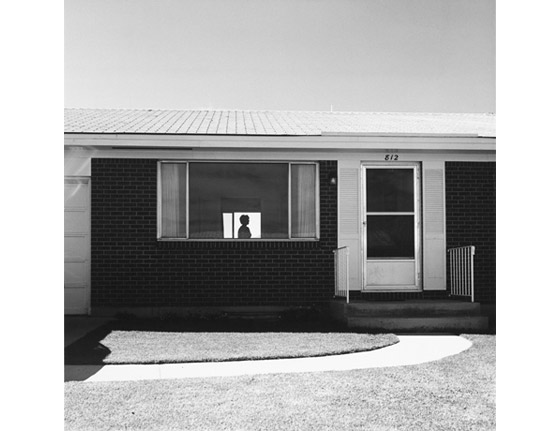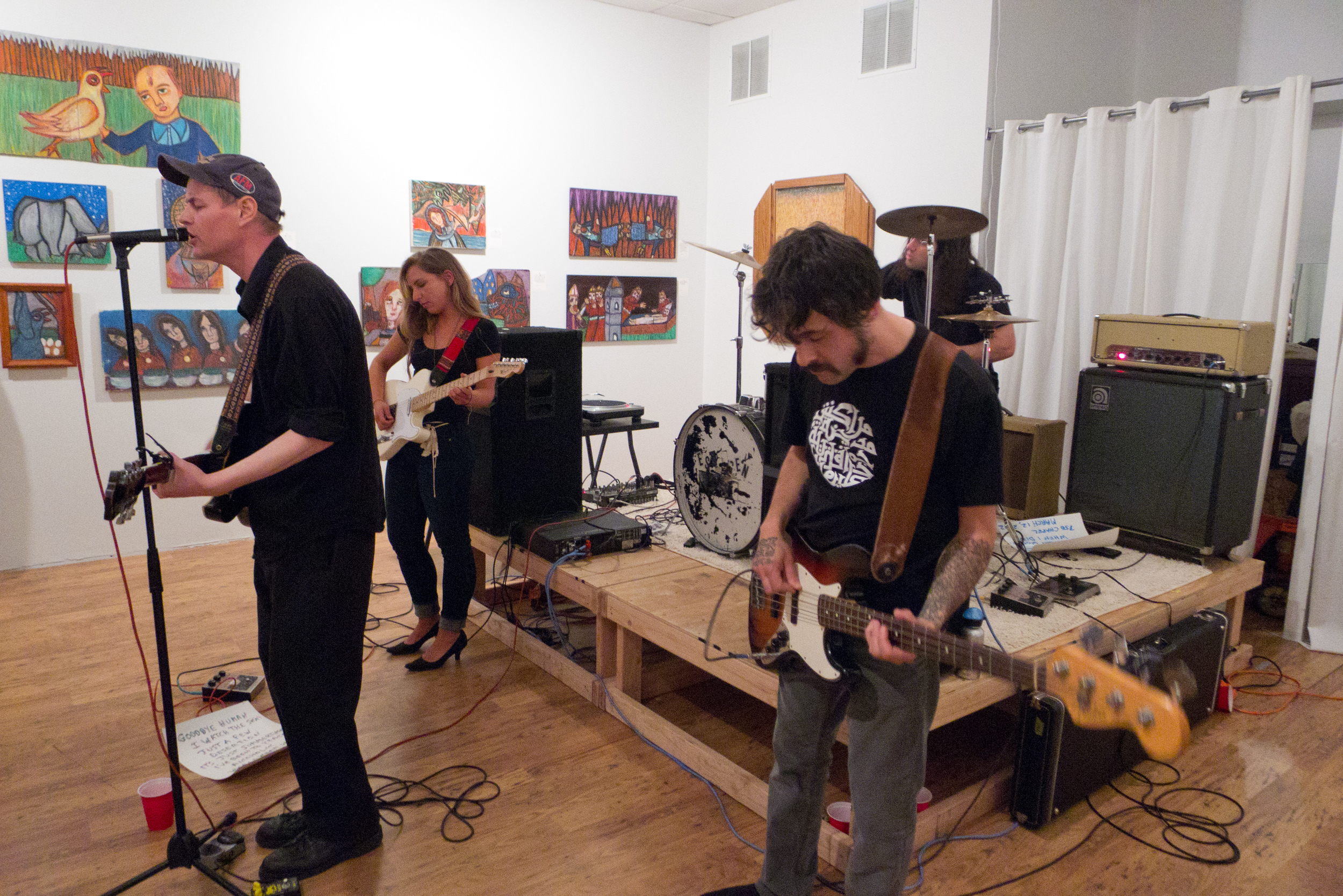“all land, no matter what has happened to it, has over it a grace, an absolutely persistent beauty.”—Robert Adams, artist statement, The New West, 1974
Persistent beauty could be said to be the theme of the Robert Adams retrospective which closes this Sunday at the Yale University Art Gallery. This is a wonderfully comprehensive show of the photography projects that Adams, a MacArthur “genius grant” recipient in 1994, has undertaken since 1968/70. Sprawling across the first and fourth floors of the Gallery, “The Place We Live” offers numerous opportunities for contemplation and reflection. Adams is not only a meticulous craftsman and a thorough master of his art, he is also an artist committed to preserving images of our nation—particularly the very land of our nation—that speak eloquently about who we really are. The amazing paradox is that even when what he shows us is not “a pretty picture”—the tract housing, the prefab corridors of business, the glut of tacky products, the clear-cutting of huge swathes of primary growth forests—each image still has considerable aesthetic fascination.
Adams sets his work in that cultural space where natural beauty meets the beauty of form in the artist’s keen eye to create the man-made beauty of his photographs. “Beauty is in the eye of the beholder” is an old adage, and Adams gives it new spirit, teaching us to see how he sees. Every image shows a lot; in the jargon of our times, we might say “contains a lot of information.” But in Adams’ images, information is not the guiding principle. Certainly, we learn something about Denver or Eden, CO, in looking at these pictures, and about areas of CA and even a sad and striking memorial for U.S. war casualties, but Adams’ work is not simply about clueing us in or letting us know. His photographs combine a formal, compositional clarity with an unflinching sharpness that makes us think about seeing, about how we choose to look at things or not.
I toured the first floor exhibit last Saturday with my friend Rob Slifkin, an assistant professor of Art History at NYU, and we spent almost two hours examining each photograph closely, rarely flagging in our admiration of Adams’ art. The earliest pictures here—so stark and yet so formally appealing, landscapes with an unerring sense of how to make us feel the contrast between the wide spaces of the west and the cramped, miminalist possibilities of the man-made objects and habitations of the time (early 1970s)—captured much of our attention, forming a canon by which to judge Adams’ subsequent work. The famous photograph of a silhouette framed in the picture window of a modest, Sixties tract-dwelling speaks with the eloquence of the perfect shot: both emblem for an entire way of life, but also an aesthetic statement about surfaces, shading, light.
In shot after shot, in his earliest period, Adams performs wonders in making the mundane and unprepossessing reveal its beauty to the eye. A street at night, where the streetlights create huge dark mounds of trees and a brightly enticing far horizon; a gutter near an undeveloped area where the asphalt road, concrete gutter, and swathe of gravel and dirt create a triptych of surfaces, each with a particular texture but also a particular reference; a baby in a car seat sitting on a stoop outside a closed screen door—a gesture toward the ephemeral made monumental, as if the child’s entire life could be summed up in the framing of that instant. We found ourselves making comparisons to Cézanne, an artist whose grasp of the formal principles of his art created new ways of seeing, looking and showing, and whose works, like Adams’ photographs, give the eye much to take in, a fascinating interplay of foreground and background and shapes and planes, voids and solids.
As we went on, it became clear that Adams’ intentions were changing. There was a period where his work became almost “Victorian” in its willingness to court “pretty” images—but with a sense of the fragility of a copse of trees, or of a place that would be done away with due to urban sprawl. By the time we were looking at the trash and detritus, the building sites and big department stores of the late Seventies and early Eighties, it became clear that Adams’ art is also socially conscious to a degree that many artists like to pretend they are. Without lecturing us, or at least by leaving the editorializing to titles and wall text, the exhibit turns a corner and begins to consider how hard it can be to find “persistent beauty” in the utter lack of taste and aesthetic sense in much of what America happily produces and consumes—and discards.
If you lived through the periods Adams is depicting, you might find yourself wincing with a terrible recognition of how “material progress” not only despoils our land, it substitutes one environment for another: one is pleasing to the eye and fully sensual in its engagement with our senses, but also, perhaps, sublime in its existence beyond us; the other is ours—indifferent to our natural preference for the irregular, the unplanned, the untouched, it simply replicates our endless search for greater ease and comfort, for more stuff, and our worship of gimcracks and commodities for the sake of novelty. Adams doesn’t need to write manifestos on the wall-cards. His images speak for themselves.
At the end of the first floor exhibit, we stood before a wall of images depicting people—actual figures in Adams’ work to this point had not been plentiful but were always meaningful. Here, we saw people of the early Eighties in shopping mall parking lots, on small town streets, in suburbs that could be anywhere in the U.S. We had already moved from considering how Adams had gone from existentialist and minimalist in his approach—showing us the “thereness” of unadorned human habitations and businesses in a vast, indifferent space—to social and editorial—showing us a way of life and its depredations. And yet the images could still yield affectionate responses and could show us “us” in no uncertain terms. In the end, we were back to formal considerations, but with a difference: to see how Adams’ artful configurations of space, shadow, figures create subliminal messages about our mortality. Rob cited Susan Sontag from “On Photography”: “Every photograph is a memento mori.” The power of these shots—and the artfulness of their seemingly artless presentation—is in how Adams makes us aware of what Sontag means when she says: “To take a photograph is to participate in another person's (or thing's) mortality, vulnerability, mutability.” What this leaves us with, then, is the effort to understand the terms and values of our “participation.” For we too are mortal, vulnerable, and mutable. And these pictures make us feel that.
Rob went off to another engagement, and I toured the fourth floor on my own. I have to confess, I took it a bit more speedily. The sheer number of photographs was becoming overwhelming. And perhaps, in the reflections above, I’d already traced a path to my moment; to the place in time and the time of the place where I was doomed to be. Or something. In any case, the upper floor is more emphatic in its outrage. Here, Adams brings his camera’s clarity to the tragic dimensions of our time: lives lost to war and landscape shorn of ancient trees both speak of phenomenal levels of waste, and, as photographs—as with shots of the northwest coast and pleasure-seekers, or a descending plane frozen, entering the open sky above a river, or of fragile plants posed almost as decorative motifs—make a strong claim on our attention. We are looking at how we live, and Adams wants us to reflect on what we see, and what that says about who we are and what we’re willing to live with.
This is a powerful and important show by an American treasure: an artist of superb skills and worthwhile convictions. Robert Adams, The Place We Live, is not to be missed. Its beauty persists.
Robert Adams The Place We Live A Retrospective Selection of Photographs Yale University Art Gallery New Haven, Connecticut August 3–October 28, 2012






